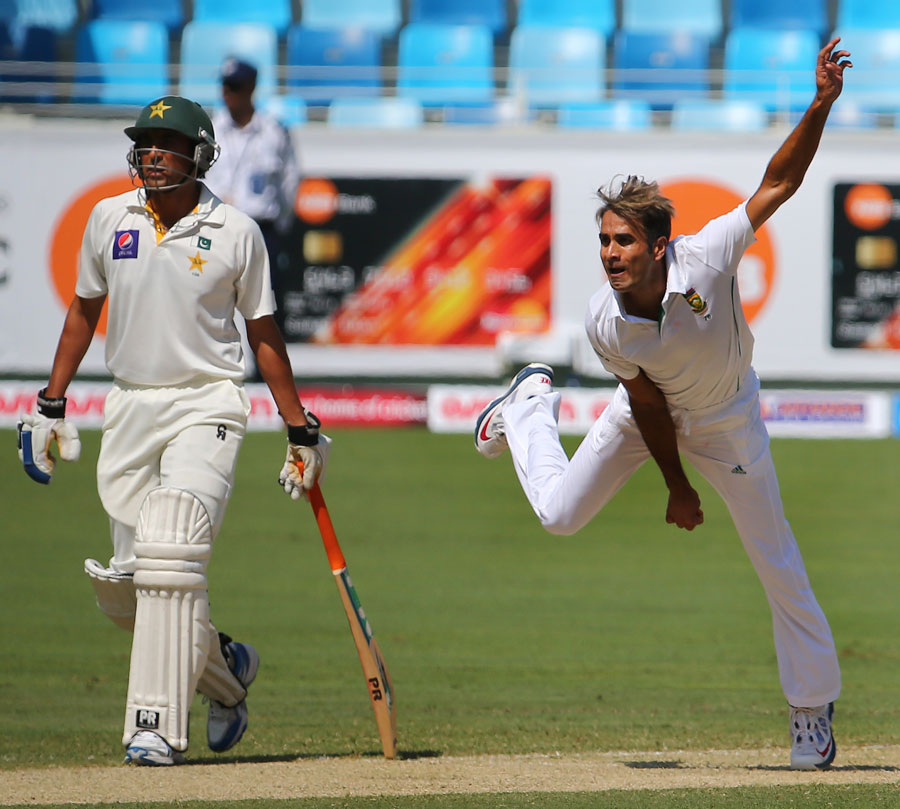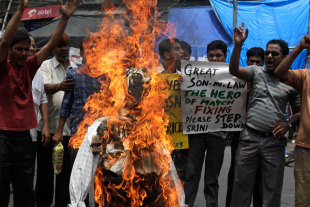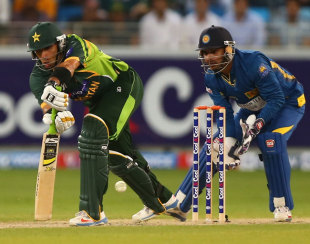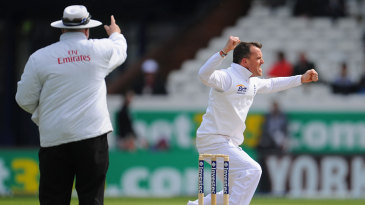No dirges for Test cricket, and the importance of Misbah

In October last year I went to watch Pakistan play South Africa in Dubai. Never in my life have I walked into a cricket ground on the first day, or any day, of a Test match in an atmosphere so desolate. The air was still, and even the trees looked lifeless. The security staff didn't seem to care either. No metal detector, no checking of bags, not even a cursory glance at my ID. Inside the vast but sparsely populated press box, Andy Zaltzman, author of the Confectionery Stall, and Statsguru devotee, pronounced with triumphant certainty that it was the first cricket match where the number of Jews in attendance outnumbered the spectators in the stands.
Zaltzman, who had stopped over in Dubai to watch the Test, was the only Jew. Outside the press box, and barring players, umpires, officials and security men, the ground was literally and metaphorically soulless.
As play began and Dale Steyn charged in with the new ball I wondered how he felt running in in front of empty seats, or how the barrenness behind the sightscreen looked to the batsman as he looked up from his meditative pause after taking guard.
This was perhaps an extreme case - it was a working day, and most people in Dubai who might be interested in cricket don't live there for recreation but to make a living - but certainly not an isolated one. Tests were played to near-vacant stands in New Zealand, in Zimbabwe, in Sri Lanka, and in the West Indies throughout the year. In Harare only a handful watched Zimbabwe pull off the rarest of Test wins against Pakistan; in Dunedin only a few more saw Darren Bravo bat for nearly nine hours after West Indies had followed on; and in Galle, Bangladesh marched to their record-breaking total before a few hundred fans.
Through the course of 2013 I also watched Tests at The Oval, the Wankhede Stadium and the Gabba, and each ground pulsated with energy and emotion. There was a hum and buzz on the way to the ground, long queues, thorough frisking at the gates, and noise and colour in the stands. But then these Tests had two of cricket's biggest draw-cards: the Ashes and Sachin Tendulkar.
On the face of it, this was cricket's great divide, between palpable passion and stark indifference, between cricket's elites and the teams that increasingly get pushed to the margins with each passing year.
But the truth about Test cricket might be located somewhere in between. Attendance, or lack of it, at cricket grounds can no longer be considered an accurate measure of support. In most parts of the developing world, going to a cricket ground is, in fact, a luxury. Fans engage with Test cricket in different ways.
We at ESPNcricinfo know it because Test matches remain our biggest draw outside of World Cups. Not only do fans follow scores avidly on computer screens, tablets and mobile phones, they also read our match reports and analyses, and comment on and discuss them. Match Point, our newly minted live analysis show during India's Test engagements with West Indies and South Africa, easily became our most-watched video programme from its very first day, and the numbers have kept multiplying. Almost every cricket fan I know watches Test matches on TV - not in their entirety but enough to keep pace with the plot and narrative. And for broadcasters in most part of the world, Test cricket is a relatively cost-effective way to fill airtime with fairly high-quality programming.
But the bigger truth lies on the field. As the morning session wore on in Dubai, I ventured out of the press box to take one of the vacant seats in the stands. Steyn had taken a wicket off the second ball, and Imran Tahir, brought on to bowl before lunch, seemed to be taking one every over. The noise of bat and ball was resounding, you could hear players talk, and they could hear you clap. Suddenly it seemed a purer, more authentic and more intimate experience. The players seemed to be in a bubble of their own, oblivious to the emptiness around them, and consumed by the contest.
That cricketers care matters. In his lecture to kick off ESPNcricinfo's 20-year celebrations, Rahul Dravid described Test cricket as the game's life source, the trunk of the tree that bears the branches carrying the fruits. But Dravid's act is over; what if those who follow him didn't bother?
Evidence was forthcoming from India's young batsmen on the tour to South Africa. India have lost nine of their last ten overseas Tests, and once again, the thinness of their bowling stood pitilessly exposed, but in the eyes of their young batsmen was hunger and desire for Test cricket. These men are millionaires and poster boys already, and their bank balances and stardom will stay intact if they only maintain their ability to belt the ball on flat pitches. In comparison, Test cricket is hard work for much less.
But how hard they fought. Of Virat Kohli and Cheteshwar Pujara it was expected. But Murali Vijay batted 375 balls, Ajinkya Rahane 442, and though the tour was a failure for him, Shikhar Dhawan, who scored 187 off 174 balls in his debut Test innings, battled for two hours in the final innings in Durban, scoring only 19 from 87 balls. Overall, a top order with a combined experience of 59 Tests had batted an average of 105 overs per innings in the series, which beat the average of their far more illustrious predecessors on recent tours to England and Australia by nearly 30 overs.
India holds the key to the future of cricket, and in their doggedness and resolve, and their stomach for the grind of Test cricket, the new generation of Indian batsmen have made a statement of reaffirmation.
****

But cricket's future won't be safeguarded on the playing fields alone. Boardrooms will play a bigger role, and foresight and vision haven't been traditional virtues of cricket's administrators. Later this month, the ICC's Finance and Commercial Affairs Committee is expected to submit to the ICC board a set of proposals with far-reaching ramifications.
It is futile to second-guess the proposals, but from the news that has filtered out, they will focus on scheduling, striking a balance between the three forms of the game, and on the distribution of the ICC's central pool of revenue. The committee is chaired by Giles Clarke, the chairman of the ECB, and among its members are Alan Isaac, the ICC president; N Srinivasan, the BCCI president; Wally Edwards, the chairman of Cricket Australia; and Dave Richardson, the ICC CEO. If anything, it can't be accused of lacking heft.
The question therefore is whether their collective will and wisdom can rise above the narrow self-interest that has guided decision-making in cricket administration in recent years. There is no doubt that the cricket calendar needs fixing, that some Test-playing countries do not pull their weight, and that there is little monitoring of the use of the funds distributed by the ICC to its members.
A feeling has persisted among Indian administrators that the BCCI's clout in cricket's power structure is resented by boards that have lost their influence. That's not unlikely because grace from the disfranchised isn't common. But the time to worry about it is long gone. The BCCI's sway over cricket affairs is unquestioned, and the world, however grudgingly, recognises and bows to its pre-eminence. It is down to the BCCI what it makes of its position.
There is a case that the hand that feeds the world must look after itself. So reliant is cricket's financial ecosystem on Indian money, which in turn relies on the devotion of millions of Indian fans, that it is in the interest of world cricket to keep the Indian fan happy. So yes, India must carve out its own home season; it must invest in finding talent. There can even be a case made that given the size of its player base and the fact that it generates most of the ICC's money, it has a bigger claim on those revenues than relatively smaller countries like England and Australia.
But it also falls on the leader to demonstrate a concern for the well-being of the game, a spirit of generosity and accommodation, and a long-term vision. It was disappointing that the BCCI let its petulance, however legitimate, over Haroon Lorgat being appointed CEO of Cricket South Africa, restrict India's tour of South Africa to two Tests. Lorgat's record as the ICC's chief executive was chequered, but fans care more about quality cricket than the egos and machinations of administrators.
Cricket needs strong leadership, and only the BCCI has the wherewithal to provide it. But to be able to do it, it must first acquire the will, and also the credibility. Fires at home must be doused first. The IPL continues to rake in the cash, but it also brews a fresh controversy every season, and this year a sword hangs over the BCCI's head in the form of an enquiry commission appointed by the Supreme Court. It would be hard to find a more twisted example of "uneasy lies the head that wears the crown".
****
Over the years, cricket hasn't been able to make up its mind about the Champions Trophy. It has been played in a knockout format, as a round robin, as a short tournament to start with, then a long one, then short again. And just when it seemed to find its bearings, it was done away with altogether. But don't bet on it not coming back.
The treatment of the Champions Trophy is symptomatic of the administrative dithering over one-day cricket. The one-day game, which remains the biggest cash earner for the ICC and for many of the national boards, has suffered from constant chopping and changing and from mindless scheduling.
The Champions Trophy was instituted in 1998 to save the ICC from bankruptcy, and till the World Twenty20 materialised, it remained the second-biggest money earner for the ICC. When the idea of a Test championship came about, the rationale, sound in principle, was do away with the Champions Trophy to give each form a trophy tournament.
There are two problems with this, though. However worthy it may be, the practicality of the Test championship has never been clear. The formula of deciding a winner on the basis of a couple of matches played in conditions that might favour one team excessively is somewhat incompatible with the idea of Test cricket itself. Plus, no satisfactory solution has been offered for how to deal with the possibility of a stalemate in one of the semi-finals. But what might ultimately scupper it is the ICC's reluctance to bear the financial implications, because TV rights to a Test championship will inevitably attract a smaller bid.
The Champions Trophy needn't have gone in the first place. If anything, one-day cricket needs less legislation and more meaning. A two-week tournament where every match counts is infinitely more watchable and memorable than the bilateral fare that's piled up thoughtlessly. Five ODIs after the Ashes? Bet Alastair Cook can't wait for them to begin.
****

Our composite ODI XI for 2013 drew a few angry responses over Misbah-ul-Haq's omission. With good reason, it can be argued. Misbah was the year's highest run-getter in the format, with 1373 runs at nearly 55. But there was also good reason why he didn't make it. The batsmen who kept him out - Virat Kohli, Kumar Sangakkara, AB de Villers and George Bailey - all scored over 1000 runs at a comparable average but at significantly higher strike rates. And they all churned out hundreds. Misbah had none.
In other words, he was the model of consistency without ever being spectacular. And he was exactly what Pakistan needed him to be. And that counts for far more than making it to a fantasy XI.
As Osman Samiuddin wrote, Pakistan were Pakistan all year. Magnificent one moment, miserable the next. It is the ability to keep the fans at the edge of their seats that has been among the most appealing aspects of Pakistan cricket, and to loyalists also the most frustrating. But Misbah is the antithesis of Pakistan cricket, and for that Pakistan cricket must be grateful.
Most Pakistani captains have been either inspirational or mercurial, or both. But Misbah, in charge of a team bereft of many world-class players, has been their anchor and their rock. With 22 scores above 50 in Tests and ODIs, he was cricket's most consistent batsman in 2013, but numbers alone can't describe his value to his team. With a smile and a straight bat, he has been both their shield and their shepherd. He is my cricketer of the year.
Read part one here












Great article and I think pretty representative of cricket followers in general. Test, by far, remain the benchmark for cricket in general. Ask Rohit Sharma which he would hold in higher regard, an ODI 100 in SA or a test 100 in SA. I would happily trade an loss in an ODI series for a win in a test series and long may it continue. Watching live test cricket is an amazing experience and I thoroughly enjoyed watching the recent Ind/SA series. Steyn vs. Rahane - awesome.
yes yes yes pakistan the best
yes yes yes Misbahulhaq is The cricketer of the year.ICC would b foolish to ignore Misbah..Singlehandedly he transformed the Unpredictable Pakistan into a world class team. forget his "tuk tuk' style.What else could he do ? When there was Harakiri at the opposite end he was Napoleonic
I think the biggest problem plaguing test cricket is the scheduling. For examplt, test matches in India are usually played between 9:30 A.M and 4:30 P.M, when most people are either working or commuting to work. Bring in day/ night tests and you'll see the crowds increasing.
empty stands in test matches. Well I am a test lover but lets be realistic. Test matches begin at 10 am and end at 6. People leave for work at 9 am and arrive at 5pm. People don't like tests. No. It interferes with their work life. Australia always generated good crowds for tests but thats because: 1. they were during school holidays and 2 they began on thursday/friday. So u have most of the weekend for the testmatches. U also have the one week christmas break for MCG and SCG tests. Fact is one: tests are currently poorly scheduled and 2. it interferes with the professional / school life. Time to introduce day night tests.
In my opinion Misbah deserves the praise. We have seen new PAK talent emerge in the last two series (SA & SL). We should hope that the selectors keep giving chances to these youngsters.
Nice article... I get why Misbah may not be featured in the Annual ODI XI. The existing batsmen in that team like Kohli, De Villiers, Sanga have had exceptional performances too. But as Mr. Bal has said, Misbah's performance was incredible in the context of his team. He has led from the front. But Misbah's greatest achievement is the sense of calm that he has brought outside the field. You just have to remember the situation when he was give the captaincy. Spot-fixing, Political maneuverings of Malik, Yousuf... but he just shut the door on that. There are no stand-offs with any player. There seem to be no factions within the team. No matter the turmoil within the PCB, the players appear relaxed. That to me outweighs any other achievement. You don't get into Fantasy XIs for that, you just become a legend.
To your question, what happens if Test championship semi-finals are stalemated, here's a suggestion. Make both semis (and the final) 2 matches each ie home and away for both teams. In case the two teams are tied after the two matches, go with whoever has the the higher overall aggregate. If the Champions League (football) can do it, why cant the cricket Test championship?
Cricket very clearly has a format problem. Its most interesting format (tests) is unwatched. At least it is not watched enough to generate any revenue outside of the Ashes and maybe two or three test grounds in India.A lot more people are interested in watching and financially supporting (just look at the ad revenues) t20 matches. Cricket should very quickly change its focus to improving the quality of the t20 format so that it captures the essence of what is good cricket while staying entertaining in a very short format. I think this writer and many others are in denial about this and are very soon going to drive all of international cricket into the ground.
The audience for the shorter format, especially T20, is growing. The IPL season directly competes with other modes of entertainment like movies.
Tests probably have a declining audience. The ad rates for Tests are probably significantly lower than premier one-day and T20 tournaments.
It would be really nice if cricinfo could put out some numbers. I checked out Alexa rankings and the audience seems to be mostly from India, Pakistan and USA (expats from Ind/Pak I presume).
This growing popularity is neither visible nor easily monetizable. The opposite is true for the other formats where stands are full and the boards make all their money by selling ad rights etc much before the tournament even starts.
In this case it is hard to fault a business-oriented organization like BCCI to not prioritize Tests.
Good time for cricinfo to monetize the game via mobile/video/internet and lure the boards to promote tests?